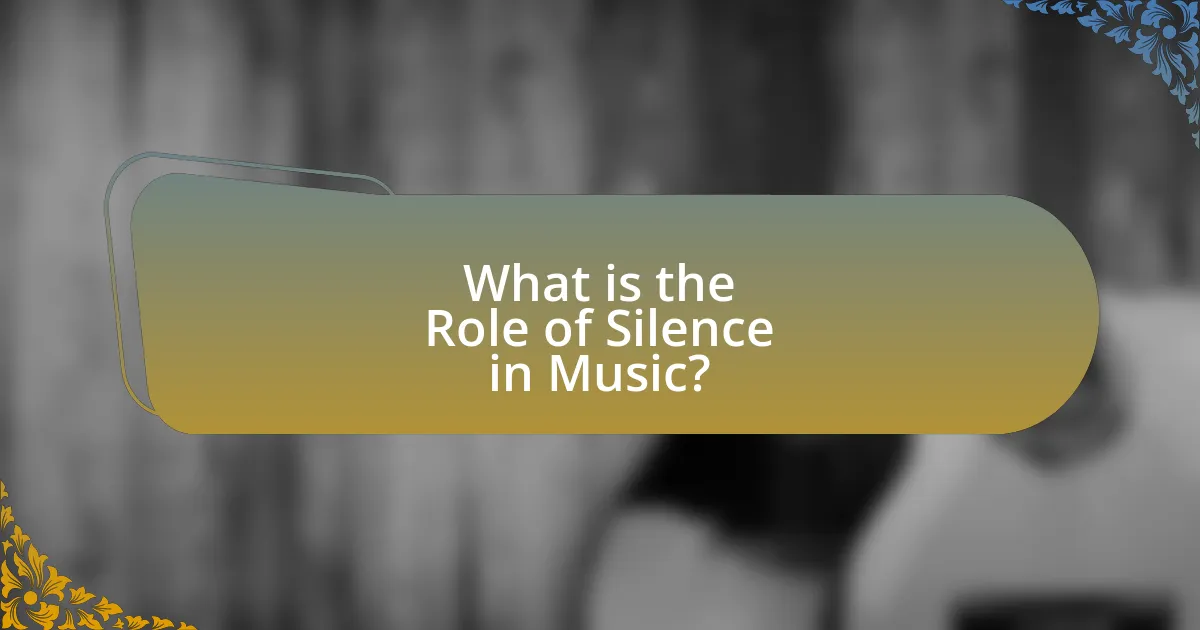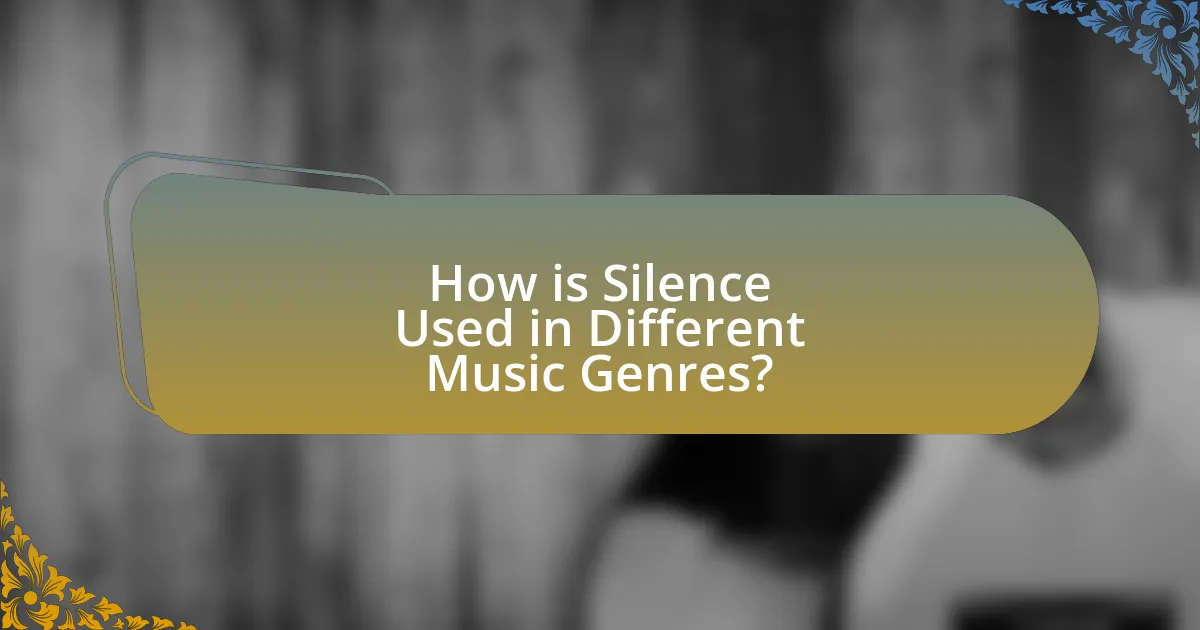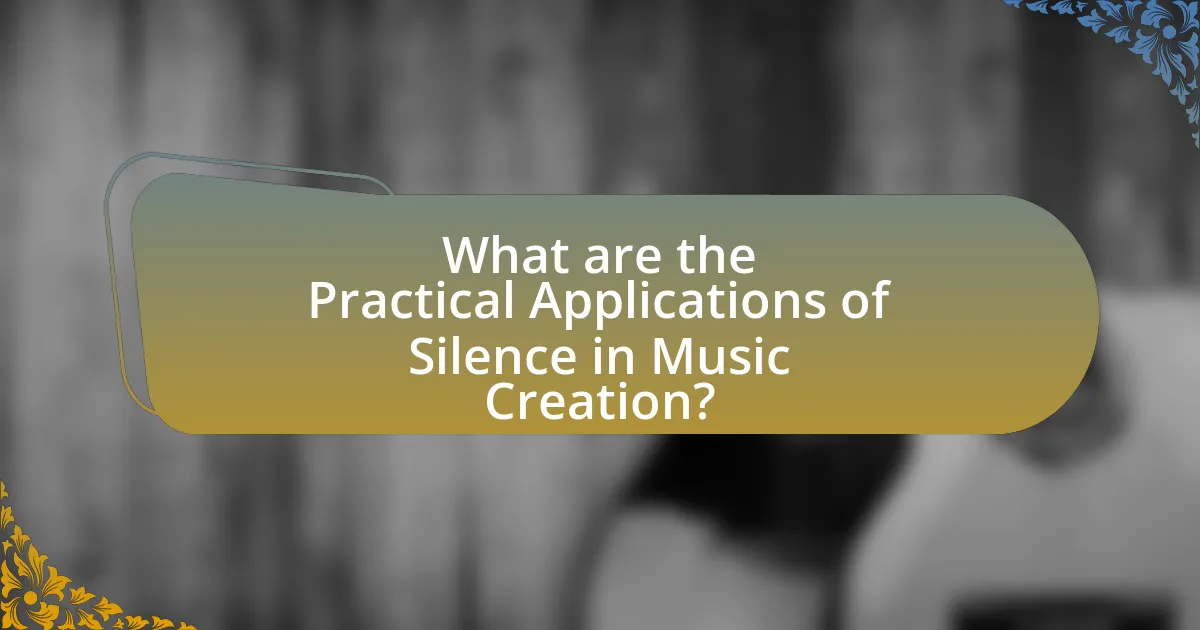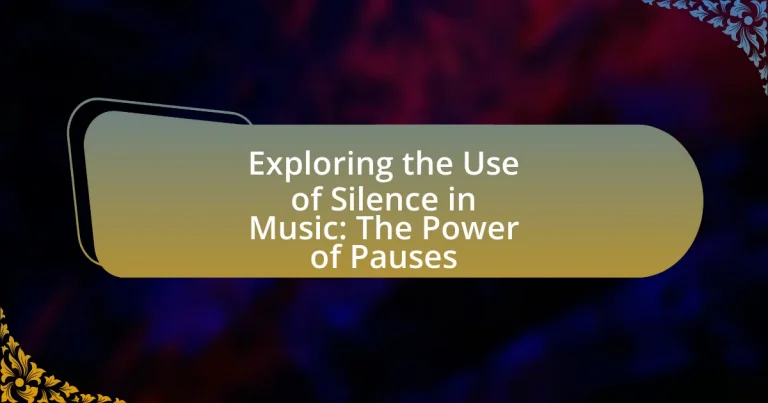The article explores the role of silence in music, emphasizing its significance as a powerful tool for emotional expression and structural dynamics. It examines how silence influences musical composition, enhances emotional impact, and creates tension through various types of silence, including absolute, measured, and contextual silence. The discussion includes examples from classical, jazz, rock, and electronic music, highlighting how silence is utilized across genres to enrich the listening experience. Additionally, the article addresses practical applications for musicians, strategies for incorporating silence effectively, and common challenges faced when using silence in compositions and performances.

What is the Role of Silence in Music?
Silence in music serves as a crucial element that enhances emotional expression and structural dynamics. It creates tension, allows for reflection, and emphasizes the notes that follow or precede it. For instance, composers like John Cage have famously utilized silence, as seen in his piece “4’33”,” which challenges traditional notions of music by highlighting the absence of sound. This use of silence can evoke a range of emotions, from anticipation to introspection, thereby enriching the overall musical experience.
How does silence influence musical composition?
Silence significantly influences musical composition by creating contrast, enhancing emotional impact, and shaping the overall structure of a piece. Composers utilize silence to provide moments of reflection, allowing listeners to absorb preceding musical ideas and anticipate what follows. For instance, in classical music, composers like John Cage famously incorporated silence into their works, such as “4’33”,” which challenges traditional notions of music by emphasizing the absence of sound. This use of silence can heighten tension, create suspense, or evoke a sense of calm, demonstrating its critical role in the emotional narrative of a composition.
What are the different types of silence used in music?
The different types of silence used in music include absolute silence, measured silence, and contextual silence. Absolute silence refers to complete absence of sound, often used for dramatic effect or to create tension. Measured silence, indicated by rests in musical notation, serves as a structured pause that contributes to the rhythm and flow of a piece. Contextual silence occurs within a musical context, where silence enhances the emotional impact or highlights specific musical elements. These types of silence are essential in shaping the overall expression and dynamics of musical compositions.
How does silence affect the emotional impact of a piece?
Silence significantly enhances the emotional impact of a piece by creating tension and allowing listeners to process the preceding sounds. In music, pauses can evoke feelings of anticipation, reflection, or even sadness, as they provide a contrast to the notes played. Research indicates that silence can amplify emotional responses; for instance, a study published in the journal “Psychological Science” by authors such as David Huron demonstrates that silence can heighten the emotional weight of musical phrases, making them more memorable and impactful. Thus, silence serves as a powerful tool in music, shaping the listener’s emotional experience.
Why is silence considered a powerful tool in music?
Silence is considered a powerful tool in music because it creates contrast, enhances emotional impact, and allows for reflection. The absence of sound can heighten the listener’s awareness of the music that follows or precedes it, making moments of sound more impactful. For example, composers like John Cage have famously utilized silence, as seen in his piece “4’33”,” which challenges traditional notions of music by emphasizing the importance of silence and ambient sounds. This strategic use of silence can evoke strong emotional responses and draw attention to the nuances of musical expression.
What psychological effects does silence have on listeners?
Silence has significant psychological effects on listeners, including heightened emotional awareness and increased introspection. Research indicates that silence can create a space for reflection, allowing individuals to process emotions and thoughts more deeply. For instance, a study published in the journal “Psychological Science” by researchers at the University of California found that silence can enhance creativity and problem-solving abilities by providing a mental break from auditory stimuli. Additionally, silence can evoke feelings of tension or anticipation, influencing the listener’s emotional response to subsequent sounds or music.
How can silence enhance musical tension and release?
Silence enhances musical tension and release by creating contrast and anticipation within a composition. When silence is strategically placed, it allows listeners to experience a heightened sense of expectation, making the subsequent musical notes or phrases more impactful. For example, composers like Igor Stravinsky in “The Rite of Spring” utilized silence to build tension before explosive musical climaxes, demonstrating that the absence of sound can amplify emotional responses. This technique is supported by psychological studies indicating that pauses in music can increase listener engagement and emotional intensity, reinforcing the effectiveness of silence in shaping musical narratives.

How is Silence Used in Different Music Genres?
Silence is utilized in various music genres to create tension, emphasize emotion, and enhance the overall listening experience. In classical music, composers like Beethoven and Mahler strategically employed silence to heighten dramatic moments, as seen in the use of rests and pauses that allow for reflection. In jazz, silence serves as a tool for improvisation, where musicians use space to create a conversational dynamic, allowing for a more expressive performance. In rock music, silence can build anticipation before a powerful chorus or solo, exemplified in tracks like “Smells Like Teen Spirit” by Nirvana, where the quiet moments amplify the impact of the loud sections. Electronic music often incorporates silence to create drops, enhancing the contrast between sound and absence, which is crucial for maintaining listener engagement. Thus, silence plays a vital role across genres, shaping the emotional and structural aspects of music.
What are examples of silence in classical music?
Examples of silence in classical music include John Cage’s “4’33″” and the second movement of Beethoven’s Symphony No. 7. John Cage’s “4’33″” is a composition where the performer does not play their instrument for four minutes and thirty-three seconds, emphasizing the ambient sounds around the performance space. In Beethoven’s Symphony No. 7, the use of rests creates dramatic pauses that enhance the emotional impact of the music. These instances illustrate how silence can be a powerful element in classical compositions, shaping the listener’s experience and interpretation.
How do composers utilize silence in symphonies?
Composers utilize silence in symphonies to create tension, enhance emotional impact, and provide contrast to musical phrases. By strategically placing pauses, composers can heighten anticipation and draw attention to subsequent musical elements, as seen in works like Gustav Mahler’s Symphony No. 2, where silence amplifies the emotional weight of the music. Additionally, silence can serve as a powerful tool for reflection, allowing listeners to absorb the preceding material, exemplified in the use of rests in Beethoven’s Symphony No. 7, which emphasizes rhythmic drive and creates a dynamic interplay between sound and silence.
What role does silence play in operatic performances?
Silence in operatic performances serves as a powerful tool for emotional expression and dramatic tension. It allows the audience to absorb the weight of the preceding music or dialogue, enhancing the overall impact of the narrative. For instance, moments of silence can create suspense before a climactic event or emphasize a character’s emotional state, making the subsequent music or action more poignant. Historical examples include the use of silence in works by composers like Wagner, who strategically employed pauses to heighten the emotional stakes in his operas. This intentional use of silence not only enriches the storytelling but also engages the audience on a deeper level, reinforcing the significance of the moments that follow.
How is silence incorporated in contemporary music styles?
Silence is incorporated in contemporary music styles as a deliberate tool to create tension, enhance emotional impact, and shape the overall structure of compositions. Artists like John Cage have famously utilized silence, exemplified in his piece “4’33”,” which challenges traditional notions of music by emphasizing the absence of sound. Additionally, genres such as ambient music and minimalism often use silence strategically to allow listeners to reflect and engage more deeply with the surrounding sounds, thereby enriching the auditory experience. This intentional use of silence can be observed in works by contemporary composers and musicians across various genres, demonstrating its significance in modern music.
What techniques do modern artists use to create pauses?
Modern artists create pauses using techniques such as silence, rests, and dynamic contrasts. Silence serves as a powerful tool to emphasize emotional moments, allowing listeners to reflect on the preceding music. Rests, strategically placed within compositions, provide a rhythmic break that enhances the overall flow and tension of the piece. Additionally, dynamic contrasts, where artists shift between loud and soft passages, create a sense of anticipation and highlight the significance of the pauses. These techniques are widely recognized in contemporary music, demonstrating their effectiveness in shaping the listener’s experience.
How does silence contribute to the overall sound in electronic music?
Silence plays a crucial role in shaping the overall sound in electronic music by creating contrast and enhancing the emotional impact of the music. By strategically incorporating silence, artists can emphasize certain sounds or beats, making them more pronounced and impactful. For instance, the use of silence before a drop in a track can heighten anticipation and create a more powerful listening experience. Research indicates that silence can also serve as a tool for rhythm and pacing, allowing listeners to process the music and engage more deeply with the composition. This technique is evident in various electronic genres, where silence is used to create tension and release, ultimately enriching the auditory experience.

What are the Practical Applications of Silence in Music Creation?
Silence in music creation serves practical applications such as enhancing emotional impact, creating tension, and providing structure. By incorporating silence, composers can evoke feelings of anticipation or reflection, as seen in works like John Cage’s “4’33”,” where the absence of sound emphasizes the surrounding environment. Additionally, silence can act as a powerful tool for contrast, allowing musical phrases to stand out more distinctly, thereby improving the overall dynamics of a piece. This technique is frequently utilized in various genres, from classical to contemporary, demonstrating its versatility and effectiveness in engaging listeners.
How can musicians effectively use silence in their compositions?
Musicians can effectively use silence in their compositions by strategically incorporating pauses to enhance emotional impact and create tension. Silence serves as a powerful tool that allows listeners to absorb preceding musical phrases, thereby heightening the anticipation for what follows. For instance, composers like John Cage have famously utilized silence, as seen in his piece “4’33”,” which challenges traditional notions of music by emphasizing the sounds of the environment during the absence of intentional sound. This approach illustrates how silence can transform the listening experience, making it an essential element in composition.
What strategies can be employed to create impactful pauses?
To create impactful pauses in music, musicians can employ strategies such as varying the duration of silence, using silence to build tension, and strategically placing pauses at emotional peaks. Varying the duration allows for dynamic contrast, making longer pauses more significant against shorter ones. Using silence to build tension can heighten anticipation, as seen in compositions like Samuel Barber’s “Adagio for Strings,” where pauses amplify emotional weight. Strategically placing pauses at emotional peaks can enhance the listener’s experience, as demonstrated in Beethoven’s symphonies, where silence often precedes powerful climaxes, creating a dramatic effect. These strategies effectively utilize silence to enhance musical expression and listener engagement.
How can silence be used to enhance live performances?
Silence can enhance live performances by creating dramatic tension and emphasizing emotional moments. When performers strategically incorporate silence, it allows the audience to absorb the preceding sounds and heightens anticipation for what follows. For instance, renowned composer John Cage famously utilized silence in his piece “4’33″” to challenge conventional notions of music, demonstrating that silence can be as impactful as sound. Additionally, studies in performance psychology indicate that pauses can increase audience engagement and focus, making the overall experience more memorable.
What are common challenges musicians face when incorporating silence?
Musicians commonly face challenges such as timing, audience perception, and emotional expression when incorporating silence into their work. Timing is critical, as musicians must accurately gauge when to introduce silence to enhance the musical narrative without disrupting the flow. Audience perception poses another challenge; listeners may misinterpret silence as a mistake or awkwardness rather than a deliberate artistic choice. Additionally, conveying the intended emotional weight of silence can be difficult, as it requires a deep understanding of the piece’s context and the ability to evoke the desired response from the audience. These challenges highlight the complexity of effectively using silence as a powerful tool in music.
How can musicians overcome the fear of silence in their work?
Musicians can overcome the fear of silence in their work by embracing silence as a powerful tool for expression and creativity. By understanding that silence can enhance musical tension and release, musicians can practice incorporating intentional pauses into their compositions and performances. Research indicates that silence can create emotional depth; for instance, the use of rests in classical music often heightens the impact of subsequent notes, as seen in works by composers like Beethoven and Debussy. Additionally, musicians can engage in mindfulness techniques to become more comfortable with silence, allowing them to appreciate its role in the overall musical narrative.
What are the best practices for balancing silence and sound?
The best practices for balancing silence and sound in music include strategically using pauses to enhance emotional impact and creating dynamic contrasts between loud and soft passages. Effective use of silence allows musicians to emphasize key moments, as demonstrated by composers like John Cage, who famously utilized silence in pieces such as “4’33″” to challenge traditional notions of music. Additionally, employing silence can create tension and anticipation, making subsequent sounds more impactful. Research indicates that silence can enhance listener engagement and retention, as it provides a moment for reflection and processing.
What tips can help musicians master the use of silence?
Musicians can master the use of silence by incorporating intentional pauses into their compositions and performances. Practicing with metronomes or backing tracks can help musicians identify where silence can enhance the emotional impact of a piece. Additionally, studying works by composers known for their effective use of silence, such as John Cage, can provide insights into how silence can create tension and release. Engaging in exercises that focus on breath control and timing can also improve a musician’s ability to incorporate silence effectively, as it allows for a greater awareness of rhythmic space.


